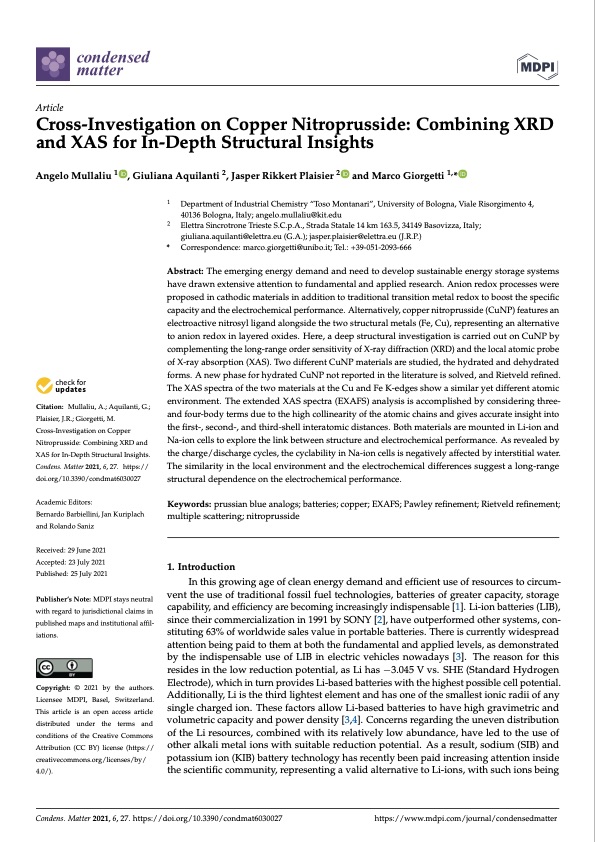
PDF Publication Title:
Text from PDF Page: 001
Article Cross-Investigation on Copper Nitroprusside: Combining XRD and XAS for In-Depth Structural Insights Angelo Mullaliu 1 , Giuliana Aquilanti 2, Jasper Rikkert Plaisier 2 and Marco Giorgetti 1,* Citation: Mullaliu,A.;Aquilanti,G.; Plaisier, J.R.; Giorgetti, M. Cross-Investigation on Copper Nitroprusside: Combining XRD and XAS for In-Depth Structural Insights. Condens.Matter2021,6,27. https:// doi.org/10.3390/condmat6030027 Academic Editors: Bernardo Barbiellini, Jan Kuriplach and Rolando Saniz Received: 29 June 2021 Accepted: 23 July 2021 Published: 25 July 2021 1 2 * Correspondence: marco.giorgetti@unibo.it; Tel.: +39-051-2093-666 Abstract: The emerging energy demand and need to develop sustainable energy storage systems have drawn extensive attention to fundamental and applied research. Anion redox processes were proposed in cathodic materials in addition to traditional transition metal redox to boost the specific capacity and the electrochemical performance. Alternatively, copper nitroprusside (CuNP) features an electroactive nitrosyl ligand alongside the two structural metals (Fe, Cu), representing an alternative to anion redox in layered oxides. Here, a deep structural investigation is carried out on CuNP by complementing the long-range order sensitivity of X-ray diffraction (XRD) and the local atomic probe of X-ray absorption (XAS). Two different CuNP materials are studied, the hydrated and dehydrated forms. A new phase for hydrated CuNP not reported in the literature is solved, and Rietveld refined. The XAS spectra of the two materials at the Cu and Fe K-edges show a similar yet different atomic environment. The extended XAS spectra (EXAFS) analysis is accomplished by considering three- and four-body terms due to the high collinearity of the atomic chains and gives accurate insight into the first-, second-, and third-shell interatomic distances. Both materials are mounted in Li-ion and Na-ion cells to explore the link between structure and electrochemical performance. As revealed by the charge/discharge cycles, the cyclability in Na-ion cells is negatively affected by interstitial water. The similarity in the local environment and the electrochemical differences suggest a long-range structural dependence on the electrochemical performance. Keywords: prussian blue analogs; batteries; copper; EXAFS; Pawley refinement; Rietveld refinement; multiple scattering; nitroprusside 1. Introduction In this growing age of clean energy demand and efficient use of resources to circum- vent the use of traditional fossil fuel technologies, batteries of greater capacity, storage capability, and efficiency are becoming increasingly indispensable [1]. Li-ion batteries (LIB), since their commercialization in 1991 by SONY [2], have outperformed other systems, con- stituting 63% of worldwide sales value in portable batteries. There is currently widespread attention being paid to them at both the fundamental and applied levels, as demonstrated by the indispensable use of LIB in electric vehicles nowadays [3]. The reason for this resides in the low reduction potential, as Li has −3.045 V vs. SHE (Standard Hydrogen Electrode), which in turn provides Li-based batteries with the highest possible cell potential. Additionally, Li is the third lightest element and has one of the smallest ionic radii of any single charged ion. These factors allow Li-based batteries to have high gravimetric and volumetric capacity and power density [3,4]. Concerns regarding the uneven distribution of the Li resources, combined with its relatively low abundance, have led to the use of other alkali metal ions with suitable reduction potential. As a result, sodium (SIB) and potassium ion (KIB) battery technology has recently been paid increasing attention inside the scientific community, representing a valid alternative to Li-ions, with such ions being Department of Industrial Chemistry “Toso Montanari”, University of Bologna, Viale Risorgimento 4, 40136 Bologna, Italy; angelo.mullaliu@kit.edu Elettra Sincrotrone Trieste S.C.p.A., Strada Statale 14 km 163.5, 34149 Basovizza, Italy; giuliana.aquilanti@elettra.eu (G.A.); jasper.plaisier@elettra.eu (J.R.P.) Publisher’s Note: MDPI stays neutral with regard to jurisdictional claims in published maps and institutional affil- iations. Copyright: © 2021 by the authors. Licensee MDPI, Basel, Switzerland. This article is an open access article distributed under the terms and conditions of the Creative Commons Attribution (CC BY) license (https:// creativecommons.org/licenses/by/ 4.0/). Condens. Matter 2021, 6, 27. https://doi.org/10.3390/condmat6030027 https://www.mdpi.com/journal/condensedmatterPDF Image | Cross-Investigation on Copper Nitroprusside: Combining XRD and XAS

PDF Search Title:
Cross-Investigation on Copper Nitroprusside: Combining XRD and XASOriginal File Name Searched:
condensedmatter-06-00027-v2.pdfDIY PDF Search: Google It | Yahoo | Bing
Sulfur Deposition on Carbon Nanofibers using Supercritical CO2 Sulfur Deposition on Carbon Nanofibers using Supercritical CO2. Gamma sulfur also known as mother of pearl sulfur and nacreous sulfur... More Info
CO2 Organic Rankine Cycle Experimenter Platform The supercritical CO2 phase change system is both a heat pump and organic rankine cycle which can be used for those purposes and as a supercritical extractor for advanced subcritical and supercritical extraction technology. Uses include producing nanoparticles, precious metal CO2 extraction, lithium battery recycling, and other applications... More Info
| CONTACT TEL: 608-238-6001 Email: greg@infinityturbine.com | RSS | AMP |